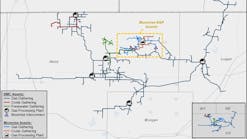CERAWeek: Regulatory hurdles still threaten US shale, CEOs say
Leaders of prominent US shale producers came together on Apr. 21 to drive home what's emerged as a primary theme during this year’s IHS CERAWeek in Houston: The urgent need to lift the export ban on US crude oil.
“It’s time to give the green light to US oil exports,” stated John Hess, chief executive officer of Hess Corp., during an upstream panel discussion alongside two other prominent US-based chief executives.
Hess emphasized that the US already exports high quantities of petroleum products—3.8 million b/d in 2014 according to the US Energy Information Administration—so why not crude?
“Mexico and Canada export crude,” he said. “Why not the US?”
Harold Hamm, chief executive officer of Continental Resources Inc., echoed those sentiments, but thinks “it’s going to take a while to change the mindset of Americans from one of scarcity to that of abundance.” He emphasized educating the public on the benefits of exports.
Hamm lamented President Richard Nixon’s “failed cost control measures of the ‘70s” that brought about current laws that are a hindrance for producers. But he’s encouraged that politicians have been listening, and believes the legislative process to remove the export ban will move forward before yearend.
Crude price impact
Hess said that lifting the export ban, thus opening up world markets, would provide US shale producers much-needed relief.
“Our crude oil is trapped here with no end in sight,” he said, adding that producers make $7-15/bbl less than if they were allowed to utilize exports to world markets. “The world is going to need our shale oil in a couple years to sustain supply, so why not [supply it] now?”
With a decline curve of 70% for many new shale wells, producers have to drill more wells to keep up with demand, which is dependent on crude oil prices, Hess said.
“We cannot grow US supply at $60/bbl,” stated Scott Sheffield, chief executive officer of Pioneer Natural Resources Co. The US can add $10/bbl to the oil price to reach $70/bbl by 2016 by lifting the export ban, he said, adding that US producers need $70-80/bbl to increase production by 500,000 b/d.
Sheffield said at current WTI prices the US can’t be the world’s “swing producer.” Hess described the Saudis as still the “price-maker,” and the US as still the “price-taker.”
Lower prices also have hindered already difficult-to-achieve advancements in international shale exploration and production. Hess noted that “we are in the early innings” of a global shale revolution, but we should temper our expectations as to how quickly it advances.
He stated that five requirements must be met—in terms of geology, mineral rights, infrastructure, fiscal regime, and a pragmatic regulatory system—within a region before shale becomes opportunistic.
“We haven’t seen those stars align yet,” he said.
Cash, production efficiency critical
Hess Corp., a major producer in the Bakken shale, is seeing cost reductions ahead of 15-30% in response to depressed crude prices. The company has cut spud-to-spud times and drilling costs in half, but Hess ultimately believes the “best way to deal with [low prices] is to leave [oil] in the ground.”
Hess nevertheless said “the Bakken is bigger and better than we ever thought it would be,” emphasizing that growth is a function of price. “We will see a lot of growth in the Bakken again.”
The company also has numerous assets beyond US shale. Hess sees US shale plateauing around 2020-25, so producers like his company need to keep their options diverse, he said.
Continental Resources, meanwhile, is doing its best to conserve cash in the current climate. “We’ve seen about a 20-25% reduction in costs over the past 4½ months,” said Hamm.
All three chief executives emphasized the importance of efficiency, a common theme amongst producers during the downturn. Hamm said drilled but uncompleted (DUC) wells are paying off for Continental, as “60% of drilling is cost completions.” The company also is seeing 16-20% recovery in the Bakken, where it's the largest acreage holder.
Sheffield touted dramatically reduced drilling times in PNR’s Wolfcamp B area of the Permian basin where the company is particularly optimistic. He said PNR essentially “was perforating the wrong zones in Spraberry-Wolfcamp” during previous years.
At the beginning of 2015, PNR reported plans to cut horizontal drilling activity in the Spraberry-Wolfcamp and Eagle Ford shale to 16 rigs by the end of February, down by half from yearend 2014.
This included 6 rigs in the northern Spraberry-Wolfcamp, 4 rigs in the southern Wolfcamp joint-venture area, and 6 rigs in the Eagle Ford. Sheffield noted the Spraberry-Wolfcamp had 7% of the world’s rig count before the downturn.
“That’s where most of our 10 billion bbl of resource potential is, but it’s going to get 65% of the capex” for 2015, he said in February during PNR’s fourth-quarter 2014 earnings call.
While Sheffield predicted that Permian production will soon “go flat,” he believes PNR alone has the potential to grow its production in the region to 1 million b/d in the right price environment. He measured that total against a study stating the Permian could potentially produce 5-6 million b/d overall.
All three executives said they intend to steer clear of layoffs as a measure in dealing with the depressed price environment. Hess said layoffs are problematic because you will need trained personnel later on when prices are higher.
Hamm said, “I may not be drilling wells, but we’re not laying anybody off,” explaining that he never got over letting go 10% of his workforce following the 1998 downturn.
Contact Matt Zborowski at [email protected].

